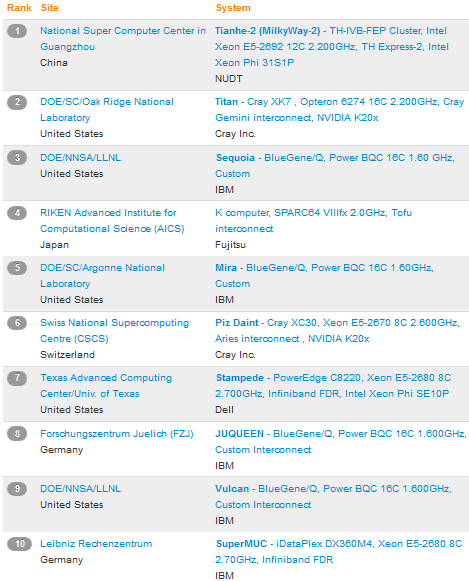While we hope you’ll stay tuned this morning for a detailed analysis of major trends on this year’s Top500 list, for now, we wanted to deliver the breaking results of this year’s systems, many of which are not surprising when compared to last year’s June list. As you can see below from the Top 10, very little movement–although there are some notable trends on the processor, interconnect, accelerator and other fronts that we will discuss later this morning.
The only surprise in the top ten this year is Piz Daint, a Cray XC30 system installed at the Swiss National Supercomputing Centre (CSCS) in Lugano, Switzerland, which now holds the title of the most powerful system in Europe. Piz Daint achieved 6.27 Pflop/s on the Linpack benchmark. Piz Daint is also the most energy efficient system in the TOP10 consuming a total of 2.33 MW and delivering 2.7 Gflops/W
As you can see above and at the full results page, Tianhe-2, at China’s National University of Defense Technology, retained its position as the world’s No. 1 system with a performance of 33.86 petaflop/s (quadrillions of calculations per second). Titan, the Cray XK7 system installed at the Department of Energy’s (DOE) Oak Ridge National Laboratory, remains the No. 2 system. It achieved 17.59 Pflop/s on the Linpack benchmark. Titan is one of the most energy efficient systems on the list consuming a total of 8.21 MW and delivering 2.143 gigaflops/W.
Sequoia, an IBM BlueGene/Q system installed at DOE’s Lawrence Livermore National Laboratory, is again the No. 3 system. It was first delivered in 2011 and achieved 17.17 Plop/s on the Linpack benchmark. Fujitsu’s K computer installed at the RIKEN Advanced Institute for Computational Science (AICS) in Kobe, Japan, is holding steady at number four with 10.51 Pflop/s on the Linpack benchmark.
Mira, a BlueGene/Q system installed at DOE’s Argonne National Laboratory, is No. 5 with 8.59 Plop/s on the Linpack benchmark.
Rounding out the TOP10 are Stampede at the Texas Advanced Computing Center of the University of Texas, Austin, which slipped to No. 7; a BlueGene/Q system called JUQEEN installed at the Forschungszentrum Juelich in Germany is No. 8; No. 9 is taken by Vulcan, another IBM BlueGene/Q system at Lawrence Livermore National Laboratory; and No. 10 is the third system in Europe, the SuperMUC, installed at Leibniz Rechenzentrum in Germany.
The total combined performance of all 500 systems on the list is 250 Pflop/s. Half of the total performance is achieved by the top 17 systems on the list, with the other half of total performance spread among the remaining 483 systems.
Other highlights from the November 2013 TOP500 List include:
- In all, there are 31 systems with performance greater than a petaflop/s on the list, an increase of five compared to the June 2013 list.
- The No. 1 system, Tianhe-2, and the No. 7 system, Stampede, are using Intel Xeon Phi processors to speed up their computational rate. The No. 2 system Titan and the No. 6 system Piz Daint are using NVIDIA GPUs to accelerate computation.
- A total of 53 systems on the list are using accelerator/co-processor technology, unchanged from June 2013. Thirty-eight (38) of these use NVIDIA chips, two use ATI Radeon, and there are now 13 systems with Intel MIC technology (Xeon Phi).
- Intel continues to provide the processors for the largest share (82.4 percent) of TOP500 systems.
- Ninety-four percent of the systems use processors with six or more cores and 75 percent have processors with eight or more cores.
- The number of systems installed in China has now stabilized at 63, compared with 65 on the last list. China occupies the No. 2 position as a user of HPC, behind the U.S. but ahead of Japan, UK, France, and Germany. Due to Tianhe-2, China this year also took the No. 2 position in the performance share, topping Japan.
- The last system on the newest list was listed at position 363 in the previous TOP500.
Geographical observations
- The U.S. is clearly the leading consumer of HPC systems with 265 of the 500 systems (253 last time). The European share (102 systems compared to 112 last time) is still lower than the Asian share (115 systems, down from 118 last time).
- Dominant countries in Asia are China with 63 systems (down from 65) and Japan with 28 systems (down from 30).
- In Europe, UK, France, and Germany, are almost equal with 23, 22, and 20 respectively.





























































